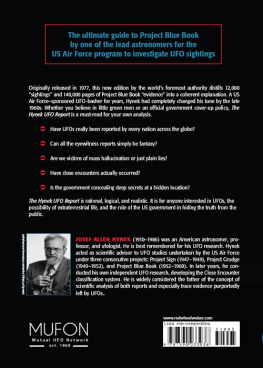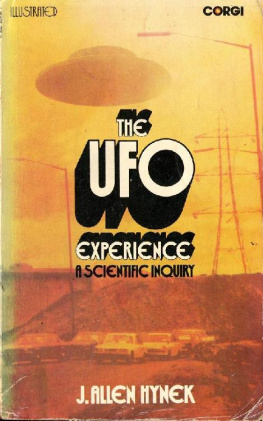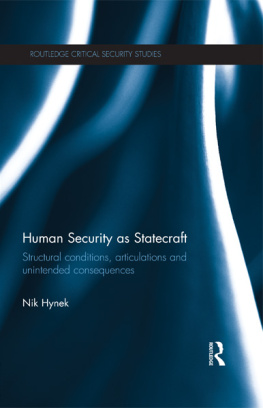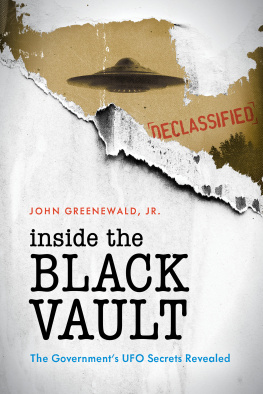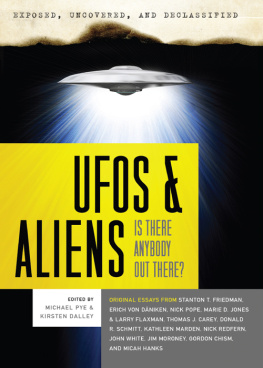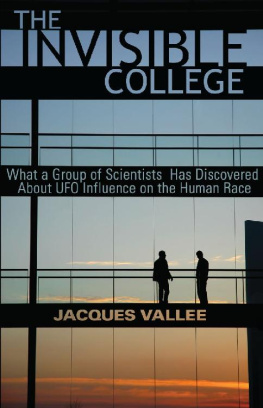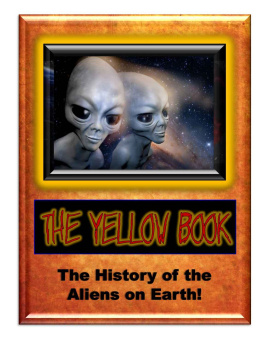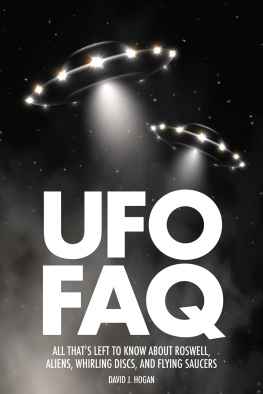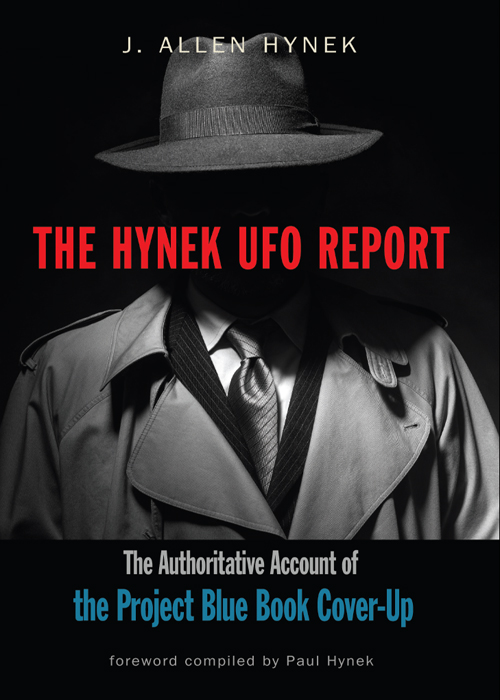

This edition first published in 2020 by MUFON, an imprint of
Red Wheel/Weiser, LLC
With offices at:
65 Parker Street, Suite 7
Newburyport, MA 01950
www.redwheelweiser.com
Copyright 2020, 1977 by the estate of J. Allen Hynek
Foreword copyright 2020 by Scott Hynek, Roxane Hynek, Joel Hynek, Paul Hynek, and Ross Hynek
All rights reserved. No part of this publication may be reproduced or transmitted in any form or by any means, electronic or mechanical, including photocopying, recording, or by any information storage and retrieval system, without permission in writing from Red Wheel/Weiser, LLC. Reviewers may quote brief passages. Previously published in 1977 by Dell Publishing.
ISBN: 978-1-59003-303-6
Library of Congress Cataloging-in-Publication Data available upon request.
Cover design by Kathryn Sky-Peck
Cover photograph by iStock
Interior by Maureen Forys, Happenstance Type-O-Rama
Typeset in New Baskerville and Franklin Gothic
Printed in the United States of America
IBI
10 9 8 7 6 5 4 3 2 1
www.redwheelweiser.com/newsletter
CONTENTS
FOREWORD
Be glad of life because it gives you the chance to love, and to work, and to play, and to look up at the stars.
VAN DYKE
J. Allen Hynek was a scientist who happened to get involved with UFOs, not a UFO buff who picked up some science along the way. It's an important distinction. He didn't come to the UFO field having seen something himself, looking for answers to something he already believed. He came because in 1948, after a flap of reports of mysterious objects in the skies, the Air Force asked him to. I don't think he ever dreamed that a part-time job consulting for the government would turn into a decades long pursuit that largely defined his career.
Dad became an astronomer in part because he respected that astronomical events such as eclipses always happened exactly when they were supposed to, unlike the erratic arrival times of trains. Clearly there was an underlying system to astronomy, and he never stopped learning about it. He especially wanted to go to the edges of the system, and help expand it. While laid up with scarlet fever at the age of seven, he read his first book on astronomy, and a new astronomer was born.
In a world where most people seemed to believe only what they wanted to believe, Dad stood out for living and breathing the scientific method. People frequently asked him if he believed in UFOs, and he invariably focused on the word believe. He'd say that he'd never seen a whale, though he'd read many credible reports attesting to their existence, but that nobody ever asked him if he believed in whales.
What he believed, what he knew to be a fact, was that there were many UFO reports. What he suspected, and sought to validate if possible, was that many of these reports were consistent with each other in some respects. What he hypothesized, often with a twinkle in his eye, was that many of them could be explained by a scientific principle that, though unknown to us today, would be common knowledge to every fifth grader one day. What he felt, and felt strongly, was that these UFO reports were not getting the kind of attention that scientific progress demanded. He didn't believe in UFOs, he accepted the validity of a growing amount of compelling UFO reports.
Dad felt that it was critically important to keep an open mind when confronted with what may be a new phenomenon, but just as important, to not simply grasp at the best available explanation, to not feel forced to come up with an answer.
He talked about the price many people paid just for reporting a UFO sighting. For some, it could end their career, for others, it meant becoming an object of ridicule or worse, for their families. Especially in the 50s, but later on as well, most people had far more to lose than gain by making a report.
It was both the increasing number of technically inexplicable reports and the people he met who made those reports that moved him from his early skepticism to pushing for a serious scientific look at the phenomenon of UFO reports. Once he came to the realization that there really was something to this post-war flying saucer craze, he found the edges of where the astronomical system started breaking down. Going to those edges with a scientific attitude in tow is what enabled him to pioneer the field of UFOlogy.
This new edition couldn't come at a better time. With the New York Times and other outlets reporting on the government's Advanced Aerospace Threat Identification Program and with the Navy admitting it has seen hundreds of UFOs and needs help with codifying reports, The Hynek UFO Report is an important flashlight on the edges of astronomical inquiry.
Theoretical physicist Richard Feynman's quote sums up our father's attitude and the spirit he brought to this book quite nicely: I'd rather have questions I can't answer, than answers I can't question.
Dad not only respected astroonomical scheduleshe actually lived his life by onecoming and going, as he predicted he would, with Halley's Comet (19101986).
SCOTT, ROXANE, JOEL, PAUL, AND ROSS HYNEK
PROLOGUE
Under the Freedom of Information Act, much government material that for years had been considered classified and otherwise restrictedmaterial from the judiciary, foreign relations, and the FBI and CIA fileshas been made available to the public. Only those matters that might jeopardize national security or involve an individual's constitutional rights continue to remain withheld.
Project Blue Book, the Air Force's project on UFOs, was always regarded officially as unclassified, but this amounted to a standing joke among those who knew better. Not only were many of the reports labeled Confidential or Secret, but the citizen who tried to examine Blue Book files was given a polite runaround or an outright refusal on various grounds. Those who sought to find out about the Air Force's investigation of UFOs were usually brushed off on the basis that the UFO files contained information that might reveal secrets about experimental military aircraft and hardware, new and advanced radar equipment and its secret locations, missiles, and military bases and installations.
In short, what was true in theory was not true in practice. Blue Book files were not open to the public, even though the Air Force claimed publicly that Blue Book was an open book.
Well, finally it is. The essentially complete files are available at the National Archives in Washington, D.C. For a price, one can obtain Or, one can examine the files in person at the National Archives. Either approach involves hours of tedious work.
The Center for UFO Studies, in Evanston, Illinois, of which I am the Scientific Director, has obtained a complete set of the microfilms, and these are available for serious students of the UFO phenomenon. I have written much of the present book from these films, adding material from my own personal experience as scientific consultant to Project Blue Book. Therefore, the reader will find in this book material that cannot be found in the files themselves.
In all, there are 13,134 reports in the Air Force files. A simple catalogue of these cases, giving only their geographical locations, dates, Air Force evaluation (and the revised evaluation suggested by my associates at the Center for UFO Studies and myself) represents a pile of sheets on my desk nearly a foot high! And these cases themselves represent only a fraction of the total number of UFO reports that have come to the attention of the Center, where a computerized data bank (called UFOCAT) of over 50,000 individual entries from all over the world is located.
Next page
